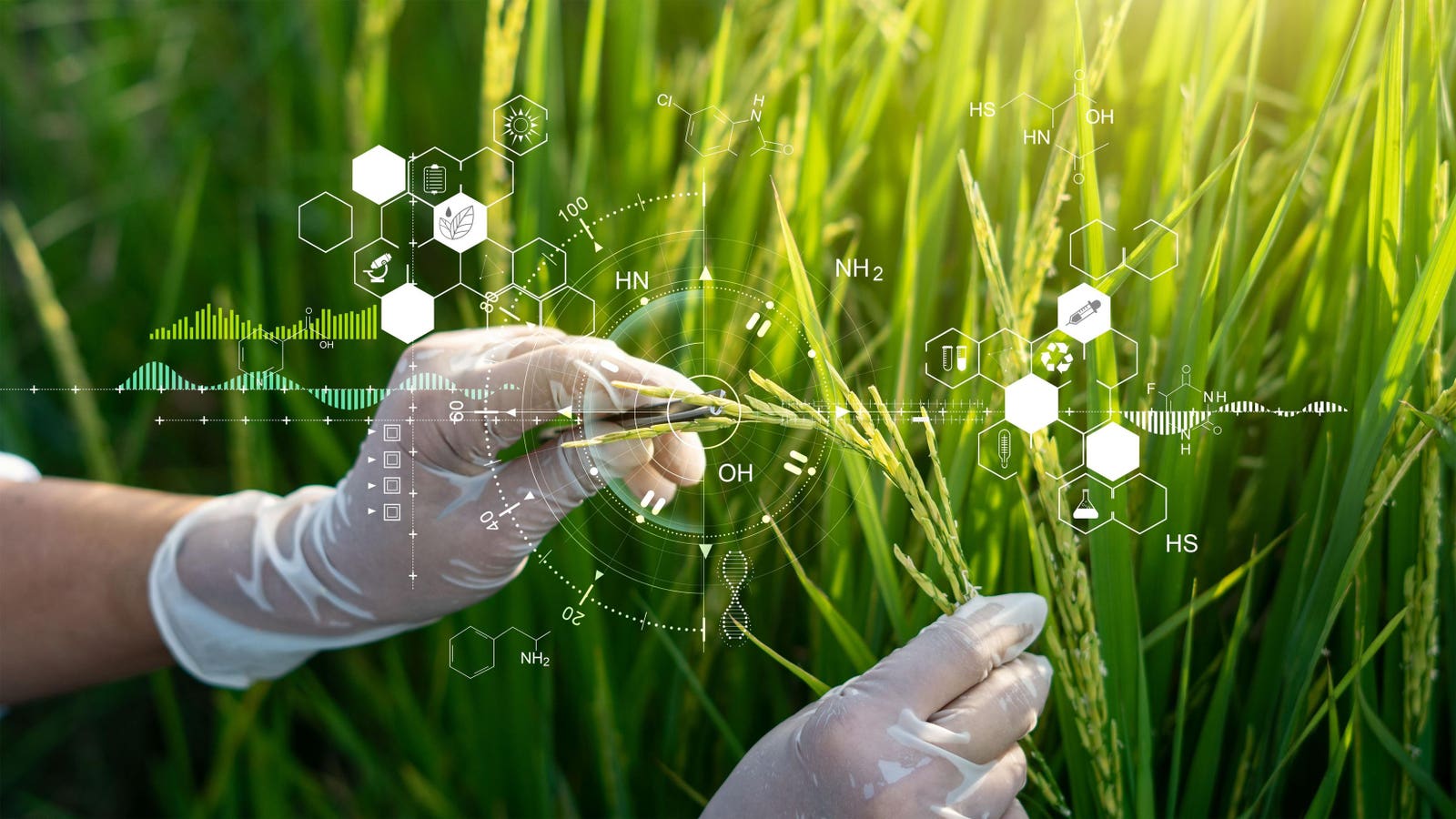- SC Commerce reports $8B of industry investment, 5,500 promised jobs in 2024 • SC Daily Gazette
- Merit Financial Advisors Partners with Zimmermann Investment Management & Planning and Establishes Fourth Office in Pennsylvania
- Private sector investment in Iran’s ports hits $4.4b
- Private equity investment can help independent doctors, health care quality, AIMPA says
- Marvell, Broadcom, Astera, Advanced Micro Devices and Semiconductor ETF
As food production faces critical challenges in 2025, top VCs point to game-changing technologies – … [+]
You are viewing: The Top Breakthrough Technologies & Investment Outlook From Leading VCs
As we enter 2025, the global food system faces a whirlwind of challenges and transformations. From surging coffee and cocoa prices to the shifting dynamics of a new U.S. administration, one thing remains clear: uncertainty looms large.
Yet amidst this turbulence, investors are identifying key themes poised to shape the future of food and agriculture. Here’s what leading food industry investors had to say about the technological innovation that are shaping the future of food.
Agricultural Biotech: The Next Frontier In Sustainable Farming
With a third of agricultural land facing moderate to severe degradation, and nearly all crops dependent on soil health, restoration has become critical for food security.
Biotechnology is emerging as a powerful solution in agriculture. “Upstream in agricultural production, biotech is unlocking much more effective and environmentally friendly alternatives to toxic pesticides and overused fertilizers,” notes Sarah Sclarsic, Co-Founder and Managing Partner of Voyager Ventures. “Watch this space.”
Investors are backing companies that combine AI and biotechnology to enhance soil health and crop yields. Companies like Andes.bio, Concert Bio, Exacto, Inevitable Technology, and RhizeBio are developing biological inputs that boost productivity while reducing environmental impact. Meanwhile, Trace Genomics and EarthOptics provide data-driven insights into soil health and resilience.
See more : Apple Boosts Indonesian Investment Proposal to $1 Billion Amid iPhone 16 Ban
These innovations are enhanced by precision agriculture technology. Precision machinery can aid in the application and efficacy of farm input innovations. “By harnessing advanced technologies like high-tech sensors, machine learning, and precise application systems, precision agriculture is empowering farmers to optimize resource use,” explains Chuck Templeton of S2G Ventures.
The GLP-1 Effect: How Medical Innovation and Personalized Nutrition Is Reshaping Food Markets
Cardiovascular disease remains the number one cause of death in the U.S., underscoring the need to address chronic illnesses through diet. Bridging nutrition science and biotechnology, companies are developing solutions to combat obesity, diabetes, and heart disease.
GLP-1-based therapies, such as Ozempic, mimic natural hormones that regulate appetite and blood sugar, reshaping perceptions of food’s role in health. “Widespread adoption of GLP-1 agonists will cause food companies to innovate towards this consumer set,” predicts Brian Bernstein of Rich’s Corporation, noting a shift toward higher-protein, nutrient-dense foods.
Startups like Thistle and Lembas Bio offer whole-food-conscious and GLP-1-friendly products, while platforms like Pom and Sylvan Health integrate tailored food solutions into daily life. As Gil Horsky of Flora VC noted, “The future of weight management might not be in pricey injections but in accessible, powerful food alternatives.”
Molecular Farming and Fermentation: Transforming Food Production
Through molecular farming and fermentation innovations, biotechnology shows significant promise in reducing our reliance on traditional agriculture. These emerging technologies could help build more resilient food production systems in the face of growing climate pressures.
Recent market volatility underscores this need. “In 2024 alone, we saw the price of eggs and chocolate skyrocket,” said Danielle Joseph of Closed Loop Partners. Corporations are actively seeking solutions to replace, enhance, or complement at-risk crops like cocoa and coffee.
One promising approach comes from Sunflower Therapeutics, which is adapting pharmaceutical-grade fermentation systems for food production. “They’ve demonstrated their capabilities in the pharma space and are now focusing on food, potentially enabling precision fermentation at viable price points,” noted Steve Molino of Clear Current Capital.
Investors are backing several companies leveraging cutting-edge bioprocesses to reduce costs and improve efficiency, including De Novo Foodlabs, Mozza Foods, and Alpine Bio. As Joseph emphasized, “Innovations in the production of life-sustaining foods and the reduction of food and organic waste are essential to the economy and our ability to build resilient societies.”
AI-Powered Automation: Transforming Food Industry Operations
The food industry faces persistent challenges in supply chain efficiency and labor shortages; 82% of food service businesses and restaurants are recruiting to fill key roles, and over half of US farms report labor shortages. Investors are looking at opportunities in robotics, advanced AI, and automation solutions to mitigate workforce limitations.
See more : Emerging markets face heavy weekly fund outflows
“AI will continue to become more impactful on the food industry, driving efficiencies across the supply chain from farm to table,” predicts Rosie Wardle of Synthesis Capital. Innovations like 4AG Robotics’ crop-harvesting solutions, Chef Robotics’ food preparation systems, and KiwiBot’s last-mile delivery robots aim to transform workflows across the supply chain.
Integrating AI-powered robotics and automation into supply chains and labor workflows could address critical labor shortages if they are genuinely cost-effective. As one investor cautioned, “Growth is hard, and profitable companies are where investment dollars are going.”
2025 Market Outlook: Investors Eye Corporate Activity and Exit Opportunities
Investor sentiment for the food technology sector in 2025 is notably more optimistic than in previous years, with corporate activity and M&A expected to drive growth. The sector is approaching an inflection point as technologies mature and valuations adjust to market realities.
“As valuations come off, companies are under pressure, and technologies are maturing, external innovation will become increasingly viable and prioritized,” notes Sara Nolet of Tenacious Ventures. This convergence of factors is creating favorable conditions for corporate investment and strategic partnerships.
The M&A landscape appears particularly promising after a prolonged quiet period. “With a falling interest rate environment and pent-up demand from two years of an M&A desert, 2025 should be much more acquisitive,” predicts Brett Brohl of Bread and Butter Ventures. Large food companies are increasingly looking to acquire innovative startups as a way to accelerate their technological transformation.
However, investors are weighing several strategic considerations. “While I’m optimistic that more dry powder sitting in later-stage funds will begin to be deployed, the question of M&A continues to be tied to what happens with interest rates,” observes Jenn Burka of FTW Ventures. This sentiment reflects a broader awareness that macroeconomic factors will continue to influence deal activity.
The path to scaling food technology may require a broader coalition of support. Jennifer Stojkovic of Joyful VC points to the critical role of public funding: “Food technology is unlikely to scale without significant government investment of non-dilutive capital.” This highlights the increasing recognition that private investment alone may not be sufficient to drive transformation at the scale needed.
Despite these considerations, the sector’s underlying momentum remains strong. The combination of corporate investment, potential M&A activity, and government support could create powerful tailwinds for food tech companies. As these forces converge in 2025, we may see a significant acceleration in deal activity—creating new opportunities for both investors and innovators.
The food industry faces no shortage of challenges, but with them comes opportunity. Technological innovation offers the chance to reimagine crop production, streamline supply chains, build the bioeconomy, and transform manufacturing processes—paving the way for a healthier and more sustainable future of food.
Source: https://magnacumlaude.store
Category: News

